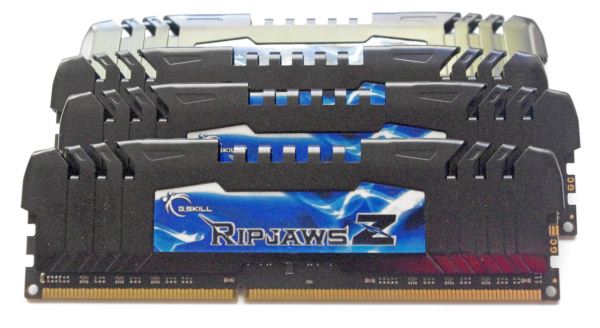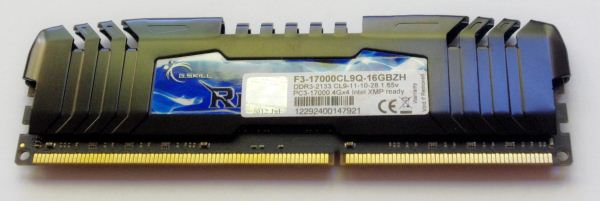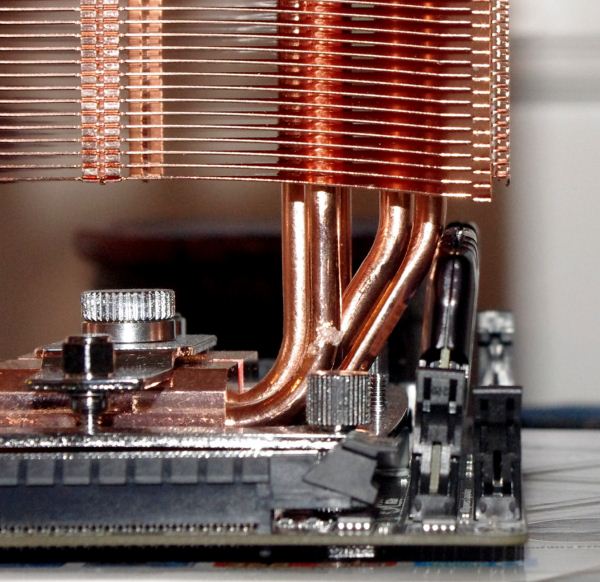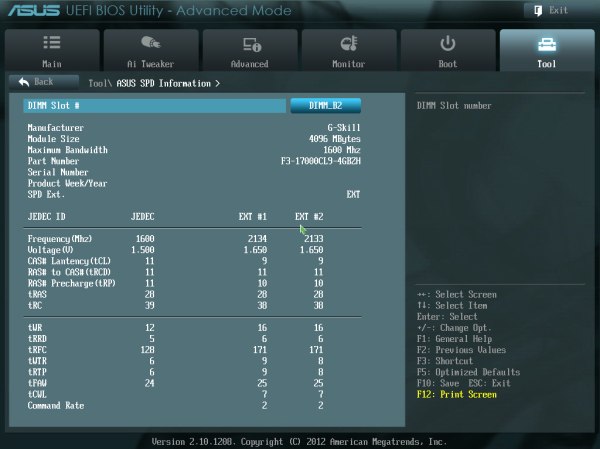Memory Performance: 16GB DDR3-1333 to DDR3-2400 on Ivy Bridge IGP with G.Skill
by Ian Cutress on October 18, 2012 12:00 PM EST- Posted in
- Memory
- G.Skill
- Ivy Bridge
- DDR3
As we go up the memory speeds, moving from 1333 to 1600 to 1866 means that the next stop is DDR3-2133. DDR3-2133 will be the next checkpoint for processors to accept by default in the future, and as a result there is a price premium for all memory kits equal and above this mark. In our case, the G.Skill F3-17000CL9Q-16GBZH comes in at $130, some $35 more than the DDR3-1866 kit. That is quite a hefty chunk, adding 37% on the price of memory for only a 14.3% increase in absolute MHz value terms. As we will see in the memory benchmarks later, the 2133 MHz point does offer improvements over the 1866 kit, but not by as much as 37%.
Visual Inspection
In the land of G.Skill and kit naming, RipjawsZ is the last step in the Ripjaws line before we hit Trident. The Ripjaws naming scheme was devised in anticipation of the Sandy Bridge and Sandy Bridge-E processor lineup where the majority of processors can achieve the speeds of all of the Ripjaws kits. The look of the RipjawsZ kits are less edge-driven than the RipjawsX, with a rounded module end, but more bulk in terms of heatsink with the top edge still being ~1cm taller than the module. This causes issues when paired with large heatsinks, despite large heatsinks being the aim of the processors paired with this kit.
Again, the test with this module in a large heatsink environment gives us the following:
JEDEC + XMP Settings
| G.Skill | |||||
| Kit Speed | 1333 | 1600 | 1866 | 2133 | 2400 |
| Subtimings | 9-9-9-24 2T | 9-9-9-24 2T | 9-10-9-28 2T | 9-11-10-28 2T | 10-12-12-31 2T |
| Price | $75 | $80 | $95 | $130 | $145 |
| XMP | No | Yes | Yes | Yes | Yes |
| Size | 4 x 4 GB | 4 x 4 GB | 4 x 4 GB | 4 x 4 GB | 4 x 4 GB |
|
|
|||||
| MHz | 1333 | 1600 | 1867 | 2134 | 2401 |
| Voltage | 1.500 | 1.500 | 1.500 | 1.650 | 1.650 |
| tCL | 9 | 9 | 9 | 9 | 10 |
| tRCD | 9 | 9 | 10 | 11 | 12 |
| tRP | 9 | 9 | 9 | 10 | 12 |
| tRAS | 24 | 24 | 28 | 28 | 31 |
| tRC | 33 | 33 | 37 | 38 | 43 |
| tWR | 10 | 12 | 14 | 16 | 16 |
| tRRD | 4 | 5 | 5 | 6 | 7/6 |
| tRFC | 107 | 128 | 150 | 171 | 313 |
| tWTR | 5 | 6 | 8/7 | 9/8 | 10/9 |
| tRTP | 5 | 6 | 8/7 | 9/8 | 10/9 |
| tFAW | 20 | 24 | 24 | 25 | 26 |
| tCWL | - | 7 | 7 | 7 | 7 |
| CR | - | 2 | 2 | 2 | 2 |






















114 Comments
View All Comments
just4U - Saturday, October 20, 2012 - link
Peaunut we are not talking 300-500 bucks here.. this is a 20-30 dollar premium which is nothing in comparison to what ram used to cost and how much more premium ram was as well.If your on a tight budget get 8Gigs of regular ram which is twice the amount of ram you likely need anyway.
Tech-Curious - Monday, November 5, 2012 - link
Thing is, these tests are for integrated graphics, unless I'm misreading something (AFAICT, the discrete card was only used for PhysX support; if I misread there then I apologize).Off the top of my head, there are basically three scenarios in which you're likely to want an IGP:
1) You're building an HTPC, in which case you prioritize (lack of) noise and (lack of) heat over graphics' power. If all you want to run are movies, then the IGP should be adequate regardless of the speed of your memory -- and if you want to play games, no amount of memory is going to turn an Intel IGP into an adequate performer on your average TV set these days. (Better to grab an AMD APU or just give up the ghost and grab a moderate-performance GPU.)
2) You're looking to run a laptop. But the memory reviewed in this article doesn't apply to laptops anyway.
3) You're on a tight budget.
So at best, we're talking about a fraction of a sliver of a tiny niche in the market, when we discuss the people who might be interested in wringing every last ounce of performance out of an IGP by installing high-priced desktop memory. Sure, the difference in absolute cost between the cheapest and the most expensive RAM here isn't going to make or break most people -- but people generally don't like to incur unnecessary costs either.
And people who are on a budget? They can save $80, just based on the numbers in the article, without making any significant performance sacrifice. That's real money, computer-component-wise.
tynopik - Thursday, October 18, 2012 - link
"I remember buying my first memory kit ever. It was a 4GB kit"makes you feel old
my first was 8MB
DanNeely - Thursday, October 18, 2012 - link
My first computer only had 16k.Mitch101 - Thursday, October 18, 2012 - link
VIC-203583 bytes free
jamyryals - Thursday, October 18, 2012 - link
wow :)just4U - Saturday, October 20, 2012 - link
The first computer i bough was a tandy 1000. I got them to put in 4 megs of ram.. at 50 bucks per meg.GotThumbs - Thursday, October 18, 2012 - link
Same here.I had purchased a used AT Intel 486DX 33Mhz powered system and upgraded it to 16mb around 1989. Overclocking it was done using jumpers on the motherboard. Heck, in HS I was a student assistant my senior year and recorded everyone's grades on a cassette tape drive using a Tandy (TS-80 I believe). It blows my mind thinking about how things have changed. There's more power/ram in a Raspberry PI than my first computer.
Best wishes for computing in the next ~30 years.
andrewaggb - Thursday, October 18, 2012 - link
Agreed, my first computer I owned personally was a 486 slc 33 (cyrix....) and I had a couple 1mb memory sticks, can't remember if those were called sims or something else. We had an apple 2+, trs 80, commodore 64, and ibm pc jr in the early-mid 80's but those were my dads :-), and some 286 that I can't remember the brand of.Just thinking about the e6400 as a first pc amuses me :-), that's still usable, and actually is when most of the computer fun started to die in my books. My current pc's are running phenom II 965, i5 2500k, i7 620m, i5 750, i7 720qm and I just have little motivation to upgrade anything ever.
Haswell is the first chip in a long time that I'm excited about. Everything else has been meh. And AMD... I had an amd 486-120,K6-200,K6-2 300,athlon xp 1800,2500, athlon 64 3200, athlon 64 x2 4800, 5600, phenom II 945,phenom x3, and my current 965 and a c-50 e netbook. man hard to believe all the computers I've had :-) Anyways, amd has nothing I want anymore, except cheap multicore cpus for running x264 all day.
IanCutress - Thursday, October 18, 2012 - link
E6400 wasn't the first PC... just the first processor I actually bought memory for. The rest were pre-built or hand-me-downs. :) I actually just took the same motherboard/chip out of my brother's computer (he has had it for a few years, with that memory) and bumped him up to Sandy Bridge. I'm still 27, and the E6400 system was new for me when I was around 21 or so. Since then I've got a Masters and a PhD - time flies when you're having fun!Ian